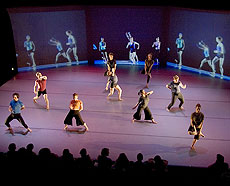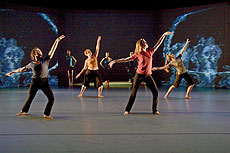April 25, 2005
UCSC, NYU join in cutting-edge dance/theater
collaboration
By Scott Rappaport
Lubricious Transfer--an ambitious dance experiment in
live, transcontinental collaboration using the Internet—was
broadcast simultaneously earlier this month to audiences at
UCSC’s Experimental Theater and New York University’s
Frederick Loewe Theater.

Students, staff, and faculty at
both universities worked together on the project.
Photos: Jim MacKenzie
|
 |
The April 15 and 16 performances were the culmination of a
distance arts education project undertaken by an interdisciplinary
mix of students, staff, and faculty at both universities. The
result was an interactive, real-time performance where UCSC
dancers performed in front of three “liquid screens,”
upon which live images of the New York University dancers were
simultaneously projected.
The project was conceived by new UCSC assistant theater arts
professor Ted Warburton and carried out in his movement research
class last quarter. UCSC’s technical staff provided the
expertise and instruction that eventually enabled students to
run all of the technical aspects of the performances.
“I believe this is the first course in the U.S. to offer
students both the opportunity to perform and to acquire the
technical knowledge necessary to produce this type of event,”
noted Warburton. “We had both groups of performers on opposite
sides of the country working together—interconnected and
interdependent—using advanced telecommunications for artistic
collaborative purposes.”
Warburton has danced professionally with American Ballet Theatre
and holds a doctoral degree in psychology from Harvard, as well
as a master’s in technology.
He came to UCSC last summer from New York University, where
he served as the director of its dance program. As a result,
he invited Ben Munisteri, an award-winning choreographer who
recently decided to attend graduate school at NYU, to collaborate
from New York. Together, they set up a series of videoconferencing
sessions to help create the event.
“There is a strong research component to this project,”
added Warburton. “We’re interested in how students’
perceptions of technology change and whether the technology
is inhibiting or enabling creativity.”
“There is not much research on distance education and
zero research on arts distance education,” he noted. “This
is a new genre of art, and we are doing creative research pushing
the boundaries of the dance discipline.”
 Email this story
Email this story
 Printer-friendly version
Printer-friendly version
 Return to Front Page
Return to Front Page